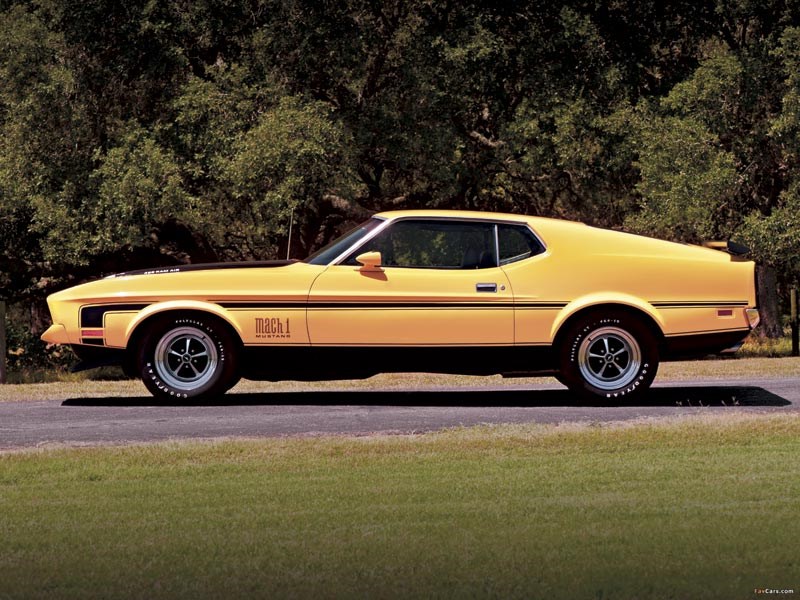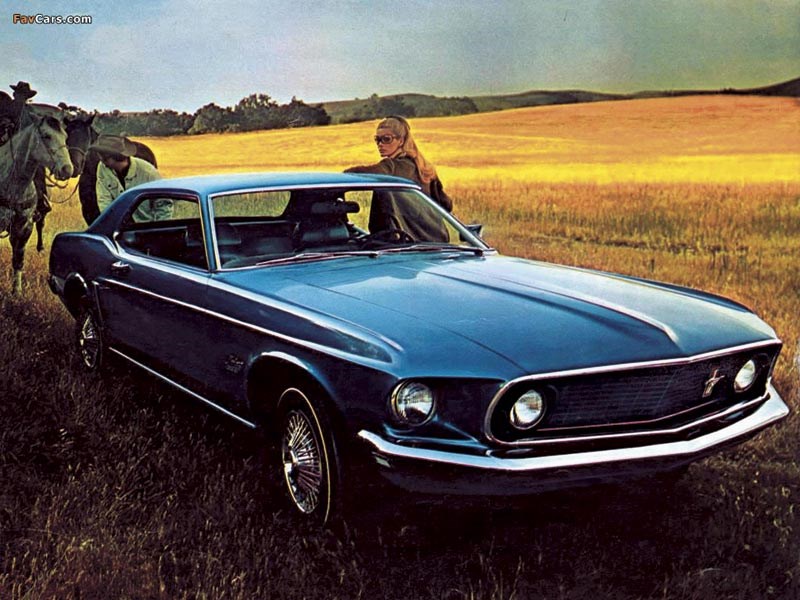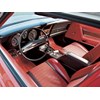1969-73 Ford Mustang: Buyers guide
 1971 Ford Mustang
1971 Ford Mustang

 1969 Ford Mustang
1969 Ford Mustang

 1971 Ford Mustang
1971 Ford Mustang


|
|
1971 Ford Mustang
|

|
|
1969 Ford Mustang
|

|
|
1971 Ford Mustang
|
Ford's second-generation Mustang range included some of the most exciting muscle cars ever made...

|
|
Buyer's guide: 1969-73 Ford Mustang
|
1969-73 Ford Mustang
WHAT IS IT?
Ford’s second generation Mustang is a car beset by contradictions. In original form, the Mustang sold on appearance and price alone; performance was so secondary that Carroll Shelby had to virtually shame Ford management into offering its own high performance versions.
Four years later a dramatically-reworked Mustang was thrust into a market obsessed by the muscle car phenomenon. The compact two-door had gained weight and taken up power-lifting in an attempt to maintain Pony Car market leadership.
The 1969 Mustang was longer, wider and up to 200kg heavier than before. Six-cylinder engines remained available, but with the robust 4.9-litre V8 costing just $105 more, few left the showroom without eight cylinders.
Visual changes to the ’69 Mustang were evolutionary; larger tail-lamps, elimination of the earlier cars’ scalloped side panels, deeper rear pillars and introduction of a longer ‘SportsRoof’ on fastback versions.
Ford added two performance-oriented models; the Mach 1 and Boss. Also new was the luxurious Grande. In basic six-cylinder form, the 1969 Mustang was priced at $2635, a 5.8-litre Mach 1 costing $504 more.
During 1969, over 72,000 Mach 1s were sold into a home market besotted by affordable cars that could crack 15 second quarter-miles. Complementing its rapid acceleration and aggressive looks, the Mach 1 included full instrumentation, knitted vinyl seats, a ‘Rim Blow’ steering wheel and a ‘Shaker’ air-intake.
The 4.9-litre Boss 302 owed its existence to the TransAm race series, Ford determined to prove that a factory-built Mustang could rival Shelby’s success. TransAm rules limited capacity to 305ci (5.0 litres), but with a reputed 325kW available, the Boss won the championship in 1969 and 1970.
For 1971, the Mustang received its first total restyle; the result an elongated betrayal of the original concept. Sales slumped from almost 300,000 in 1969 to 135,000 for the 1973 model year.
Safety regulations and fuel consumption concerns also took their toll; the 1973 Mach 1 was almost 2sec slower to 60mph (96km/h) than its thirstier, dirtier 1969 counterpart.
Weirdest of all Ford’s 1971-73 Mustangs was the near-horizontal SportsRoof — nicknamed the ‘Flatback’ — which made reverse parking an exciting, sometimes expensive adventure. Convertible production surged from 6400 in 1972 to almost 12,000 in 1973, before the soft-top Mustang had been legislated out of existence.
HOW'S IT DRIVE?
Debate still rages over the merits of left-to-right-hand drive conversions. Post-conversion issues include vague steering response and increased turning circle. Better news is that these 1969-73 ’Stangs can now be fully registered in Australia without the cost or trauma of conversion.
The view forward on a 1969-70 Mustang is impressive, though rear vision is very restrictive. Mach 1, Grande and cars equipped with the Deluxe Interior Décor Group options pack had woodgrain dash trim, three-spoke steering wheels and a saucer-sized ‘rally clock’. Seats were less inviting; hard and slippery on base-models, cross-ribbed with higher backs and marginally better lateral support on the Mach 1. After 1971, Mustang interior design sank into the mire which beset all 70s Fords; think XC Falcon.
While straight-line performance is the motivating factor for many buyers, pre-1971 cars have a genuine racing heritage and can be made to handle and stop well. Various suspension combinations are available, while ‘big-block’ Mach 1s and Boss versions used staggered rear shocks for improved axle location. Understeer is the prevailing trait, making Mustangs more at home in the wide open spaces than confined suburban streets.
CHECKLIST
Mustangs rust and even recently-restored cars can harbour corrosion in hard-to-reach spots. Check the rear quarter panels for any sign of bubbling or excessive bodyfiller; floors, firewall, doors, sills and inner mudguards too. Be wary of rust in the turret of vinyl-topped cars. Inconsistent panel gaps signify poor repairs, although ‘dropped’ doors are common, especially on convertibles. Make sure the hood mechanism on convertibles works properly. Thankfully restoring a Mustang isn’t difficult as components are available new or second hand from Mustang specialists here and overseas.
Virtually any Mustang engine of this age will be simple to recondition or replace. Big-blocks and the Boss 302 with its big-valve cylinder heads and sundry performance modifications are scarce and anyone shelling out top dollars for one needs to be convinced of the powerplant’s authenticity. Clubs and internet websites can help by matching build codes to installed components.
Auto gearboxes are generally reliable and virtually unbreakable; slurred upshifts or a slow response to manual downshifts indicate that reconditioning isn’t far away. Manual transmissions can be difficult when cold, but are durable. Ford differentials are legendary for their toughness.
Mustang suspensions are ultra-conventional and simple to replace. Front shock absorbers on V8s take a pounding, but can be upgraded for longer life. Groaning ball-joints are common and rear leaf springs can crack. Cars converted during the days pre-engineering certification need to be expertly checked as some converters used suspect parts and techniques.
The electrical system is robust but check that the power top on convertibles, plus electric windows and air-conditioning (where fitted) are working. Post-’71 V8 coupes used a printed circuit rear window defroster, which is usually inoperative.
Inside the cheap interior trim suffers wear and sun damage, but replacing split seat coverings or warped door trims is simple and relatively inexpensive. Replacements for damaged instruments or switchgear will need to be found on the second-hand market.
SPECIFICATIONS
Ford Mustang 1969-73
Body: 2-door coupe, fastback or convertible
Engines: 3278cc six-cylinder, OHV; 4098cc six-cylinder, OHV; 4949cc V8, OHV; 5753cc V8 OHV; 6392cc V8, OHV; 7015cc V8, OHV; 7031cc V8, OHV
Power: 157kW (4.9L 2bbl); 216kW (4.9L Boss 4bbl); 224kW (5.8L 4bbl); 250kW (7.0L CJ); 280kW (7.0L Boss)
Gearbox: 3- or 4-speed manual, 3-speed automatic
Suspension: independent, coil springs, telescopic shocks, anti-roll bar (f); semi-elliptic springs, telescopic shocks, anti-roll bar (optional) (r)
Brakes: disc/drum (f); drum (r). Power assist optional
Price: $7,000 - $115,000
*****
More reviews:
> World's Greatest Cars: Shelby Mustang GT350
> USA vs Oz: 1966 Ford Mustang vs 1967 Ford XR Falcon GT
> Legendary 1967 GTA mustang racer
Search used:
>> Search Ford Mustangs for sale
Unique Cars magazine Value Guides
Sell your car for free right here
Get your monthly fix of news, reviews and stories on the greatest cars and minds in the automotive world.
Subscribe

.jpg)









.jpg)

